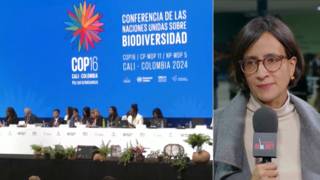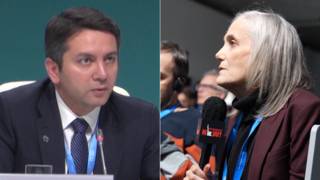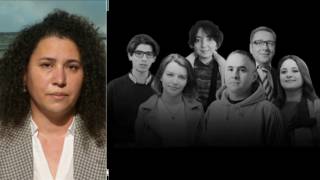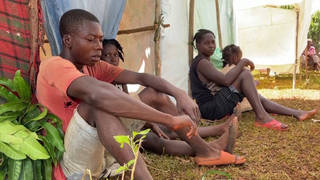
Related
As thousands of well-equipped US soldiers pour into Haiti, there is an increasing concern about the militarization of the country, supporting the soldiers and not the people. Or, as one doctor put it, “people need gauze, not guns.” We take a look at aid distribution in Haiti and the effect on Haitians fighting to survive in the aftermath of the earthquake. [includes rush transcript]
Transcript
AMY GOODMAN: Haiti is preparing for a massive relocation of survivors of last week’s earthquake out of the capital Port-au-Prince. Some 400,000 people will be moved to camps outside the city. Up to two million people were left homeless by the 7.0-magnitude quake, which is estimated to have killed as many as 200,000 people.
As thousands of well-equipped US soldiers pour into Haiti, there is an increasing concern about the militarization of the country, supporting the soldiers and not the people. Or, as one doctor put it, “We need gauze, not guns.” Relief workers continue to report dire shortages of food, aid and medical supplies, amidst fears the dire conditions will spark outbreaks of infectious disease.
Today, we take a journey to the epicenter of the earthquake in Haiti. We go from Port-au-Prince through Carrefour and Gressier to Léogâne. We begin at Matthew 25 House in Port-au-Prince. I went to Haiti with Democracy Now! producer Sharif Abdel Kouddous, videographer Elizabeth Press and Haiti Liberté writer Kim Ives. We talked to Sister Mary Finnick, speaking about the lack of adequate aid and after the earthquake.
SISTER MARY FINNICK: If we had gotten aid by even Wednesday night — what is now going to take place and what’s going to be on American television are the riots, the shooting, and that’s exciting for people to see, but it should not have happened. It didn’t have to happen. If we had gotten the supplies, people, by now, would be more than likely out of the city of Port-au-Prince. There’s plenty of places in Haiti for them to go to. We didn’t have any fuel. We can’t get them to get their cars out. They wanted to go out.
There was truly a very organized plan on the part of the Haitian people. But what you’re going to see now are the riots. When the food comes in, if you’ve been hungry for a whole week, if your child is dying of malnourishment — over and over again we said we have to have a plan. Well, disasters don’t do well with waiting for a plan. And I’m afraid what I think is going to happen is what the American people will see are undisciplined, horrible Haitian people, who are probably the best in the world with dealing with their adverse poverty. Their spirit is just fantastic. And I’m just sorry that that’s not what’s going to be seen, because nobody was here to film it. Nobody was here to watch how they organized themselves. What they’re going to see is how they are disorganized, and that’s such shame.
SASHA KRAMER: My name is Sasha Kramer, and I came out of Cap-Haïtien. I’m based there with a group called SOIL, Sustainable Organic Integrated Livelihoods. And we’ve been working in Cap-Haïtien for the last five years, mainly on sanitation and garbage transformation.
What I’ve been witnessing here is that the aid actually arrived fairly quickly. So, very quickly, they had ships there with supplies, medical supplies, water. As I understand, there’s thousands of tons of food that are available. But the problem that they’re having is distribution of the aid.
And one of the issues with that is that large aid organizations working in Haiti, because it’s an area that has a State Department warning, there’s a lot of regions in Port-au-Prince that are considered red zones that they’re not able to go into without very high security restrictions. So when the large aid groups circulate around Port-au-Prince, they’re often in sealed vehicles with their windows up, and what this means is that they’re not able to develop good relationships with community leaders. Often they don’t speak Creole, as well, a lot of their international employees. So when a large disaster like this happens, and they need to be able to get into the neighborhoods to distribute the food, they are afraid to go in, because they don’t have the connections they would need in order to keep them safe and distribute the food in an organized manner. So, as I understand it, there’s a lot of aid just waiting to be distributed.
And we met with a lot of community groups from Port-au-Prince yesterday who said, “Hey, you know, our main need is water. We have water. We have people who will give their wells. We have community people who have water trucks, who are ready to distribute the water. It’s a question of gas. And we just need to be able to connect with the larger aid organizations to get that gas, and then we can get the water to the communities.”
AMY GOODMAN: But the hurricanes, four, one after another after another, that hasn’t led to any kind of international aid organization, UN communication with the local community groups?
SASHA KRAMER: Well, I mean, I think that they have limited communications still, I would say. I don’t know. That’s because after the hurricanes happened, security restrictions got even higher for international aid groups, because they said, well, Haiti is even more insecure now. So you’re even less able to circulate in the communities. So it’s been this very self-perpetuating process, where, at this point, the Haitians on the ground who are ready to do something have no way to connect with the people down at the UN base who have all the materials to make a difference.
CATHERINE LAINE: I’m Catherine Laine. I am the deputy director of the Appropriate Infrastructure Development Group.
We found a lot of what the news report has been reporting is inaccurate. I think typically the story that they have about Haiti is it’s always unstable and there’s always gunshots. In terms of the security, we’ve noticed that during the daytime things are pretty safe. We have heard gunshots here at night. And within the unorganized — or the settlements where people are getting into, they’ve noticed insecurity, particularly at night. We were speaking with community leaders yesterday, and they expressed a real concern and a desire, amongst other things, in terms of water and food, but also for lighting at night, because, as one of our colleagues mentioned, they’re like a bunch of mice sleeping among cats. And there have been instances of girls and women being raped, because of lack of lighting. So, in terms of the larger security picture of Haiti as being crazy, in the daytime it’s safe, but at nighttime people are unprotected, and it is very unsafe at night for people out in the community.
AMY GOODMAN: And what has been your experience with international aid groups working with community groups?
CATHERINE LAINE: From what I’m understanding and from what I’m seeing, you typically see like the big organizations have their big white vans, and they’re quite sealed off from the community. They’re not — because of security restrictions, they’re not allowed to take local transportation. And the types of normal interactions you might expect people to have after being in — working in a country for a long time, they’re not really allowed to develop, because of their security policies. And so, what we’ve seen here is that the aid delivery is very slow.
One reason is, to be fair to MINUSTAH and a lot of the larger organizations, a lot of their buildings were destroyed. And the UN, in particular, lost a lot of staff. So for them to be able to get their logistics machinery set up and rolling has been difficult for them. So that’s one reason. But another is that they don’t have the connections within the community to be able to get things out quickly. And I think that’s a major failure of the way that larger aid organizations comport themselves, in general.
MARC OREL LISIUS: My name is Orel Lisius, and I’m the national coordinator for SOIL, in SOIL, Sustainable Organic Integrated Livelihoods in Haiti. So, right now we are on our way to send family members to a countryside, because the situation is very difficult for them. And I can say smelling — very smell bad. So I have to move them, because we have some kids and some babies. So, we know what kind of impact it’s going to have on their health, so that’s why today we’re going to send them to somewhere else.
AMY GOODMAN: Where?
MARC OREL LISIUS: In Cap-Haïtien, to spend, I mean, a little time.
AMY GOODMAN: Where is your — what happened to your house here in Port-au-Prince?
MARC OREL LISIUS: By the grace of God, nothing will happen to my house. And there’s some kind of little issue inside, but it wasn’t broken down like some others’ house have been broken. And since I’ve got there, I heard that nobody sleep inside of the house, because they don’t want their house fell again to kill all the people. That’s why I’m going to move those families somewhere.
AMY GOODMAN: You said it smells bad. Why does it smell bad?
MARC OREL LISIUS: Because, you know, there’s a lot of people died. There’s a lot of bodies. There’s no space that’s — even though the cemetery. In the cemetery, there’s no space to put some bodies. So right now, our people are obliged to accept that they live with bodies and, I mean, decompositions, like if I can say that in English.
You know, so it’s — you know, I’m sorry, because there’s some other people who don’t have nowhere to go. They don’t have. But I’m lucky that I got opportunity to get a car and I’m with my organizations to transport my family. But I would like to do that for every — for every other families. But we don’t have a big opportunity to do that and big transportations to do.
AMY GOODMAN: Haitian activist Marc Orel Lisius saying goodbye to his family as they made their way to Cap-Haïtien. Rosemond Jolissaint, known as Ti Rosemond, hitched a ride with them. He’s the most famous young musician in Haiti. When he was sixteen, he won Haiti’s version of American Idol. He got into the back of the pickup truck with Marc’s family and sang “The Misery of the Peasant.”












Media Options